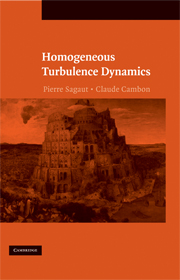Book contents
- Frontmatter
- Contents
- Abbreviations Used in This Book
- 1 Introduction
- 2 Statistical Analysis of Homogeneous Turbulent Flows: Reminders
- 3 Incompressible Homogeneous Isotropic Turbulence
- 4 Incompressible Homogeneous Anisotropic Turbulence: Pure Rotation
- 5 Incompressible Homogeneous Anisotropic Turbulence: Strain
- 6 Incompressible Homogeneous Anisotropic Turbulence: Pure Shear
- 7 Incompressible Homogeneous Anisotropic Turbulence: Buoyancy and Stable Stratification
- 8 Coupled Effects: Rotation, Stratification, Strain, and Shear
- 9 Compressible Homogeneous Isotropic Turbulence
- 10 Compressible Homogeneous Anisotropic Turbulence
- 11 Isotropic Turbulence–Shock Interaction
- 12 Linear Interaction Approximation for Shock–Perturbation Interaction
- 13 Linear Theories. From Rapid Distortion Theory to WKB Variants
- 14 Anisotropic Nonlinear Triadic Closures
- 15 Conclusions and Perspectives
- Bibliography
- Index
5 - Incompressible Homogeneous Anisotropic Turbulence: Strain
- Frontmatter
- Contents
- Abbreviations Used in This Book
- 1 Introduction
- 2 Statistical Analysis of Homogeneous Turbulent Flows: Reminders
- 3 Incompressible Homogeneous Isotropic Turbulence
- 4 Incompressible Homogeneous Anisotropic Turbulence: Pure Rotation
- 5 Incompressible Homogeneous Anisotropic Turbulence: Strain
- 6 Incompressible Homogeneous Anisotropic Turbulence: Pure Shear
- 7 Incompressible Homogeneous Anisotropic Turbulence: Buoyancy and Stable Stratification
- 8 Coupled Effects: Rotation, Stratification, Strain, and Shear
- 9 Compressible Homogeneous Isotropic Turbulence
- 10 Compressible Homogeneous Anisotropic Turbulence
- 11 Isotropic Turbulence–Shock Interaction
- 12 Linear Interaction Approximation for Shock–Perturbation Interaction
- 13 Linear Theories. From Rapid Distortion Theory to WKB Variants
- 14 Anisotropic Nonlinear Triadic Closures
- 15 Conclusions and Perspectives
- Bibliography
- Index
Summary
Main Observations
This chapter is devoted to the dynamics of homogeneous turbulent flows submitted to a pure strain. The pure strain case is defined as the case in which the mean-velocity-gradient matrix A is symmetric. As discussed in the rest of this chapter, several experimental setups have been designed during the past few decades that lead to different forms for A. Kinematic aspects, from the design of ducts in experiments to a first insight into RDT (more details are given in Chapter 13), are also introduced in the general case in which A combines a symmetric and an antisymmetric part (mean vorticity) in order to characterize in the simplest way what the specificity is of an irrotational straining process.
Both experiments and numerical simulations lead to the following observations dealing with the dynamics of homogeneous turbulence subjected to pure strain:
The initially isotropic turbulence becomes anisotropic in the presence of a mean strain, and the principal axes of the RST become identical to those of the A, the axis of contraction for A corresponding to the direction of maximum amplification for the RST. If the strain is applied for a long enough time, anisotropy reaches an asymptotic state. Typical results are displayed in Fig. 5.1.
[…]
- Type
- Chapter
- Information
- Homogeneous Turbulence Dynamics , pp. 167 - 191Publisher: Cambridge University PressPrint publication year: 2008



